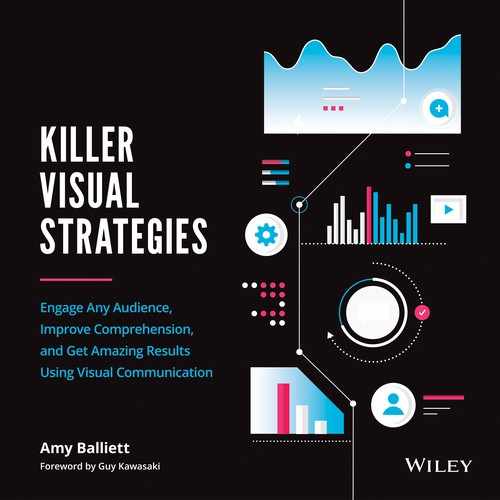FOREWORD

I first came across Killer Visual Strategies, the visual communication agency founded by Amy Balliett, in 2011. That year represented a critical juncture—not just for the fledgling Seattle company, which was just getting their footing in the market, but in the history of visual communication. Smartphone usage was rapidly expanding. A social media platform called Instagram was fresh on the scene. More and more of our information came from nontraditional sources like Facebook and YouTube. And the content we were sharing was overwhelmingly visual.
Amy had launched her company, then called Killer Infographics, to meet a fast-growing demand for infographics from organizations in just about every industry. In fact, Killer first came to my attention when they designed an infographic—now a classic in marketing circles—that pitted me against fellow marketing guru Seth Godin in a tongue-in-cheek standoff (Figures F.1 and F.2). The way in which this and other pieces of visual content—including a motion graphic adaptation of the infographic in 2012—spread virally across the web piqued my interest. These new types of visual content were perfectly suited for posting and sharing on emerging platforms. And people were engaging with them much more than they were with text.
Our world is transforming faster than ever, and visual communication is at the heart of that transformation. Ever since I worked for Steve Jobs as an evangelist for Macintosh, and later for Apple, I knew that good design was fundamental to business success. It wasn't just about the words we used—it was about how we told our story as a company. And that story was about envisioning a better future—with an emphasis on “vision.”
For any individual or company looking to make a real difference, storytelling is not just powerful—it's essential. In my career as a venture capitalist, I've heard more pitches than I can count that used hot-button words and jargon, but failed to really deliver a sense of the company's value. To succeed, every organization needs to focus on their purpose, not their product. They must be clear on how they will contribute to a better, brighter future. And communicating that purpose requires visual storytelling.
That's why, in 2014, I became the chief evangelist of Canva, an online service whose goal was to make graphic design easy for people without access to a dedicated design team. Visual content has become intrinsic to how we all communicate, and I knew there was potential in a company that could facilitate such communication. As it turns out, I was right—demand for visual content from consumers and brands alike seems to be growing exponentially. We now expect brands to communicate visually; anything less is not enough.
Today's marketing is therefore visual by necessity. Quality visual communication—from motion graphics to interactive experiences to social-media micronarratives—is no longer an option for brands. Whether you're taking a photo of your office, preparing a pitch deck for investors, or designing an ebook, you're putting content out in the world that represents your brand. And it needs to represent your brand well.
Visual content doesn't just offer a way for you to build brand recognition. High-quality content will demonstrate your company's commitment to delivering real value. And, perhaps most importantly, the right visual identity for your business will empower you to tell your story in a way that attracts and retains your audience's attention. Because in the end, no brand will succeed without building meaningful relationships with customers and potential customers. Visual communication shows them how their story aligns with yours and envisions what you can accomplish together.
More and more, I'm seeing brands embrace visual content in their internal communication efforts as well. From video training and interactive professional- development modules to company newsletters and boardroom presentations, visual content is driving meaning-making in every aspect of our lives. Branding, meanwhile, is now a company-wide endeavor. Everyone from the CEO to the summer intern should know what your brand identity is and why.
A decade after Killer Visual Strategies was founded, this agency remains at the forefront of innovation in visual communication. They produce more types of visual content than I can count, but they offer much more than that. The Killer team specializes in producing visual content that achieves our goals as marketers. After all, visual marketing is only successful when it's on-message, channel-optimized, and audience-centered.
At the helm of this ship, Amy Balliett has become a global leader in visual communication and visual content marketing, and I can think of no book right now that's more relevant to marketers, designers, and brand leaders than the one you hold in your hands. No matter where your story takes you, this book will be a worthy touchstone along the way.
—Guy Kawasaki
Chief Evangelist of Canva

